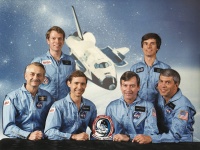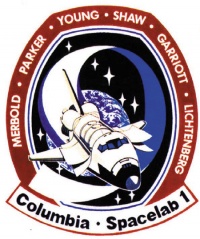STS-9
From The Space Library
 | |
| Organization | NASA-Office of Space Science Applications (UnitedStates),NASA-Office of Space Flight (United States),European Space Agency (International) |
|---|---|
| Mission type | Astronomy,Human Crew,Life Science,Microgravity,Solar Physics,Space Physics |
| Launch date | November 28, 1983 |
| Launch vehicle | Space Shuttle |
| Launch site | Cape Canaveral, United States |
| COSPAR ID | 1983-116A |
| Experiments | Here |
| Alternate Names | Spacelab 1/STS 9,14523 |
| Additional Information | Here |
| Data Collection | Here |
| Payload Mass Up | 14500.0 kg |
The first Spacelab mission was a joint NASA and European Space Agency (ESA) mission. Spacelab 1 consisted of a pressurized compartment (module) for housing equipment and flight personnel and a space-exposed platform to accommodate instruments. The compartment and platform were flown into space and returned inside the payload compartment of the Space Shuttle. The mission lasted 10 days, and while in space, the Shuttle payload compartment doors were opened to allow viewing of the earth, sun, and deep space. Spacelab 1 was a multidiscipline mission comprising five broad areas of investigation: Atmospheric Physics and Earth Observations, Space Plasma Physics, Astronomy and Solar Physics, Material Sciences and Technology, and Life Sciences. The Atmospheric Physics investigations conducted studies of the earth's environment through surveys of temperature, composition, and motion of the atmosphere. The Earth Observations investigations used and evaluated the capability of advanced measuring systems for making topographic and thematic maps from high-resolution photographs and from remote-sensing data. Investigations in the Space Plasma Physics group studied the charged particle or plasma environment of the earth. The Astronomy investigations studied astronomical sources of radiation in the ultraviolet and X-ray wavelengths. The Solar Physics investigations measured the total energy output of the sun using three different methods with the instruments cross calibrated so that meaningful comparisons could be made. The Material Sciences and Technology investigations took advantage of the microgravity conditions to perform studies in such areas as crystal growth, metallurgy, tribology, fluid physics, and ceramics technology. The Life Sciences investigations were concerned with the effects of the space environment (zero gravity and high-energy radiation) on human physiology and on the growth, development, and organization of biological systems. The mission was considered very successful.

